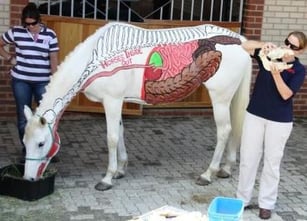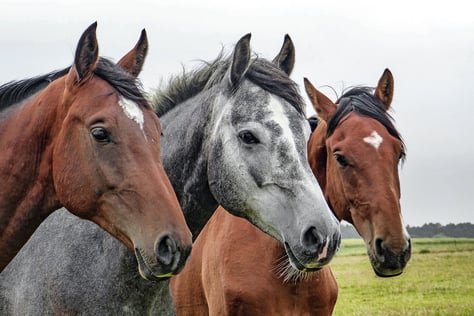 Horses are herbivores, or roughage eaters. They are grazing animals with digestive systems designed for constant consumption of plant food. Very much like humans, the horse’s digestive system is a twisty-turning roller coaster ride for any food that the horse eats. It takes about two to three days for food to pass through this last and largest part of the equine digestive tract.
Horses are herbivores, or roughage eaters. They are grazing animals with digestive systems designed for constant consumption of plant food. Very much like humans, the horse’s digestive system is a twisty-turning roller coaster ride for any food that the horse eats. It takes about two to three days for food to pass through this last and largest part of the equine digestive tract.
Starting in the mouth, the chewing (mastication) of the food starts the process. Enzymes from the horse’s saliva start breaking down the food into various, reduces it into small particles so it can be easily digested and absorbed. From the mouth, the partially digested food moves to the oral part of the pharynx (or pharynx)) and into the esophagus, where the food takes a 50-60 inch slide down to the stomach. An extremely strong muscular sphincter at the junction of the esophagus and stomach helps move the food along. This muscle was developed to allow horses to keep digesting even if they have to suddenly run off to avoid a predator. But it’s this muscle that also keeps a horse from vomiting. If a horse eats something it shouldn’t, there isn’t a way to induce vomiting to rid the poison from his system. The stomach store, mixes, digests and propels feed into the small intestine. Very little of the feed nutrients are absorbed in the stomach. Proteins and carbohydrates are only partially digested in the stomach, and fats are only slightly hydrolyzed before the food passes into the intestine.
From there, the food passes through seventy feet of small intestine! The liver and pancreas both have ducts with openings that lead to the small intestine. The liver delivers bile and the pancreas delivers digestive enzymes and both help to further break down the food. Once the food is broken down into its components (e.g., amino acids, simple sugars), these microscopic nutrients are absorbed in the small intestines along with vitamins and minerals. In the human digestive system, a pear-shaped organ called the gall bladder is located below the liver and stores the bile secreted by the liver. Horses don’t have a gall bladder.
The small intestine then connects to the large intestine. The large intestine is an important source of water and electrolytes for horses that don’t have adequate water. Horses can absorb water from the large intestines to help avoid dehydration. The remainder of the horse’s meal is primarily structural carbohydrates—the fibrous components of forage such as cellulose. These carbohydrates pass from the last part of the small intestines (the ileum) into the first part of the enormous large colon (the cecum).
The cecum is an 18-inch to 24-inch blind sac that processes the food through fermentation, where it passes from the cecum to the large colon (comprised of the right and left ventral colons, and left/right dorsal colons) to the transverse and descending colons. The rate of feed movement through the colon is relatively slow. Because the colon folds back on itself several times and its diameter varies, horses are predisposed to digestive upsets when nutrient flow is abnormal. Since the horse's digestive tract is primarily designed to digest forages, fewer problems occur when the diet is predominately hay or pasture.
Keep your horse’s digestive system healthy by providing plenty of clean water, good quality hay or pasture and plenty of exercise. A regular de-worming program will help eliminate parasite damaging infestations and regular dental care will ensure that your horse is grinding his food efficiently.
Horses do best when fed several small meals throughout the day rather than one large meal. To make feeding your horse easier, many of the Classic Equine Equipment stalls have swivel hay and/or grain feed doors, swing out water bucket holders and hay racks. Classic Equine also has several feeding and watering options, including the EQUIFount Horse Waterer and corner grain and hay feeders.



